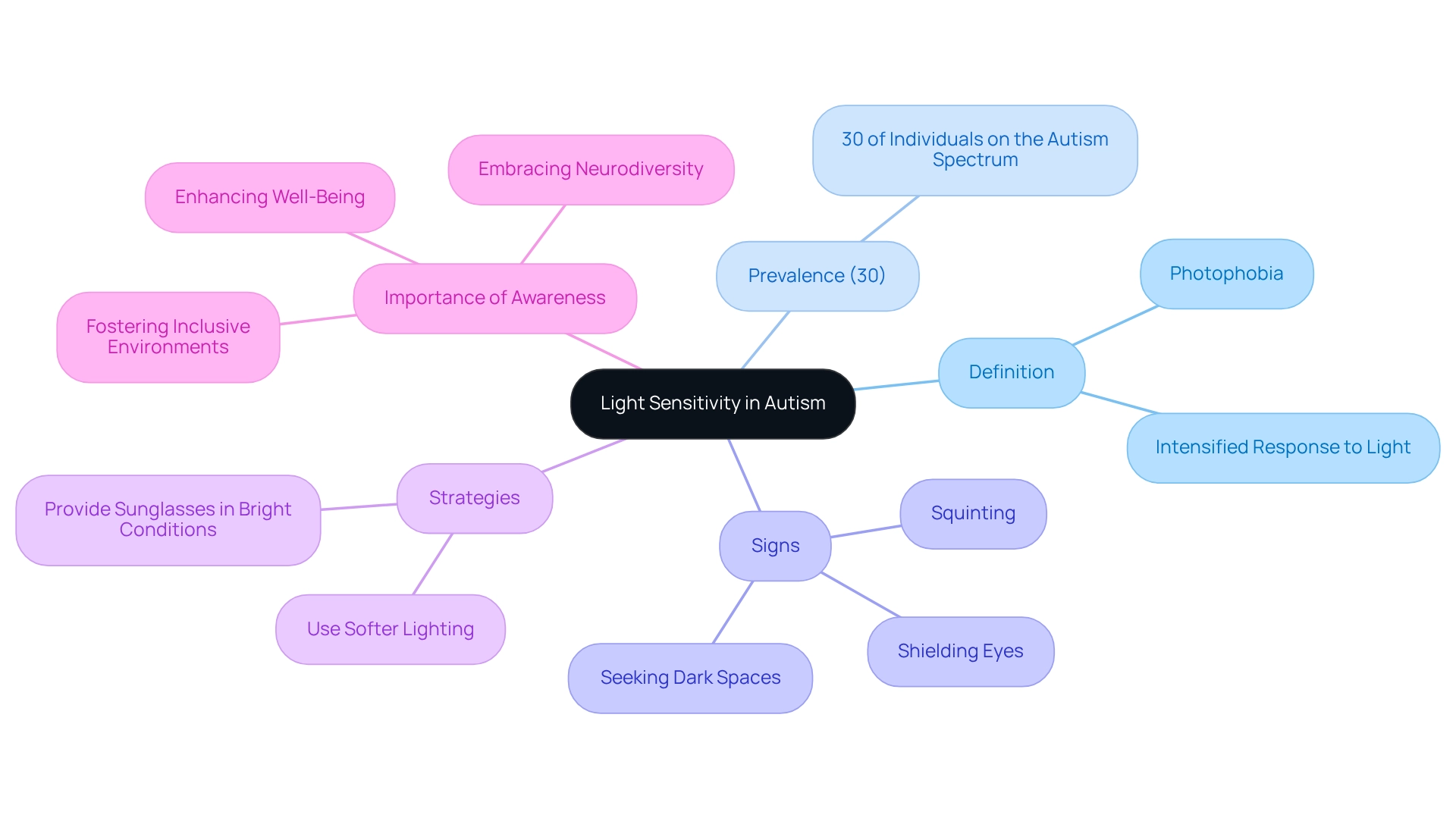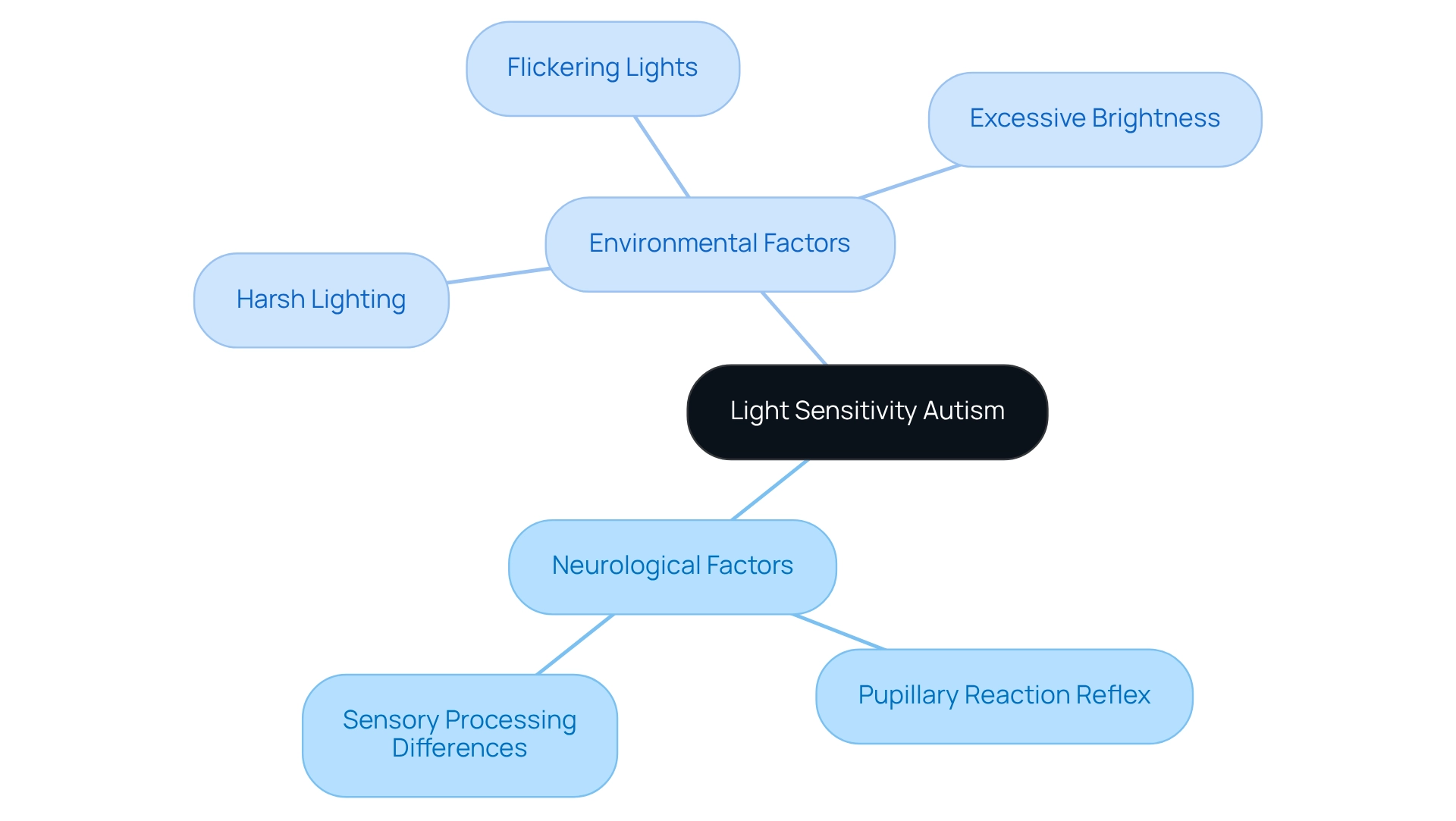Overview
Light sensitivity in autism is a challenge that many families face, with approximately 30% of individuals on the autism spectrum experiencing an intense aversion to bright lights and discomfort in illuminated environments. Understanding this condition is crucial for parents, as it can significantly impact their loved ones' daily lives. Symptoms such as squinting or irritability often arise in these situations, highlighting the need for awareness and support.
By exploring the causes and symptoms of light sensitivity, we can better appreciate the experiences of those affected. Implementing management strategies, such as using softer lighting and protective eyewear, can create a more comfortable environment. These adjustments not only alleviate discomfort but also enhance the overall well-being of individuals on the spectrum.
We encourage parents to share their experiences and strategies in the comments, fostering a supportive community. Together, we can navigate these challenges and find solutions that work for our loved ones. Let's take action to create brighter, more accommodating spaces for those who need it most.
Introduction
In a world where sensory experiences profoundly shape our daily lives, light sensitivity emerges as a significant concern for many individuals on the autism spectrum. Clinically known as photophobia, this heightened aversion to bright lights can cause discomfort, distress, and avoidance behaviors, impacting approximately 30% of those with autism.
Understanding the nuances of light sensitivity is vital for caregivers and educators, as it empowers them to create supportive environments tailored to the unique needs of these individuals. By recognizing symptoms and implementing effective management strategies—such as adjusting lighting and establishing safe spaces—caregivers can play a pivotal role in enhancing comfort and overall well-being.
As awareness of light sensitivity continues to grow, so does the potential for fostering inclusive settings that celebrate neurodiversity and empower individuals to thrive.
Define Light Sensitivity in Autism
Reactivity to brightness, clinically known as photophobia, is characterized by an intensified response to light that can lead to discomfort or pain for those with light sensitivity autism. This condition often manifests as a strong aversion to bright lights, prompting avoidance behaviors or significant discomfort in certain lighting situations.
Research indicates that approximately 30% of individuals on the autism spectrum experience light sensitivity autism, underscoring the prevalence of this issue within the community. Understanding light responsiveness is crucial for caregivers and educators, as it enables the creation of supportive environments tailored to the unique needs of individuals on the spectrum.
By recognizing signs of photophobia—such as squinting, shielding the eyes, or seeking out darker spaces—caregivers can implement effective strategies to alleviate discomfort. For instance, using softer lighting can reduce glare and cultivate a more soothing atmosphere, while providing sunglasses in bright conditions can help individuals manage their discomfort more effectively.
Experts emphasize the importance of addressing light sensitivity autism to enhance the overall well-being and comfort of individuals with autism-related conditions. As noted by Els for Autism, 'The global mission of Els for Autism is to transform the lives of individuals with developmental disorders and those who care for them through lifetime services and collaborative partnerships.'
Ultimately, raising awareness and understanding of light intolerance can foster more inclusive and supportive environments for those affected. Moreover, embracing neurodiversity, as highlighted in the case study 'Celebrating Diversity through Autism Quotes,' nurtures a compassionate society that values the unique strengths of individuals on the spectrum.

Explore Causes of Light Sensitivity
The phenomenon of light sensitivity autism arises from a complex interplay of neurological and environmental factors. Neurological differences, especially variations in the central nervous system, play a crucial role in how sensory information is processed. For example, impairments in the pupillary reaction reflex can contribute to light sensitivity autism, leading to an exaggerated response to brightness that causes discomfort or distress. Additionally, environmental factors—such as exposure to harsh, flickering, or excessively bright lights—can intensify reactions in individuals with light sensitivity autism. Understanding these underlying causes is vital for caregivers, as it empowers them to create more accommodating environments that alleviate discomfort associated with light sensitivity autism and enhance overall well-being.
Research underscores the importance of thoughtful design in spaces frequented by neurodivergent individuals, suggesting that adjustments in lighting can significantly improve comfort and usability for those with light sensitivity autism. As highlighted in the case study "The Importance of Understanding Neurodiversity in Lighting Design," considerate lighting design can greatly benefit not only those with sensory challenges but also the broader community.
ABA centers in Texas, New Jersey, and Georgia offer support in creating comfortable environments, stressing that inclusive lighting is a fundamental step toward fostering spaces where everyone can thrive. By promoting awareness of these issues, caregivers can more effectively assist those with sensory processing challenges, including light sensitivity autism, in managing their sensory experiences.

Identify Symptoms of Light Sensitivity
For many individuals with autism, light sensitivity autism can manifest in various ways as signs of brightness discomfort, often leading to significant unease in brightly lit environments. You may notice common indicators such as squinting, covering the eyes, or even headaches. Behavioral changes, including irritability or withdrawal, are also frequent; children with light sensitivity autism may react negatively to intense lighting. In some instances, physical symptoms like nausea or dizziness can arise, complicating their experiences even further.
Recognizing these symptoms is crucial for caregivers. By doing so, you can implement effective strategies to minimize exposure to triggering environments. Early recognition and intervention have been shown to lead to improved outcomes, highlighting the importance of awareness in addressing sensory challenges. Moreover, evidence-based adjustments can create inclusive lighting, significantly enhancing comfort for those with light intolerance, particularly those experiencing light sensitivity autism. Research indicates that sensory symptoms in young children with ASD often follow a developmental trajectory, underscoring both their prevalence and significance. A case study titled 'Challenges in Longitudinal Research on Sensory Symptoms' emphasizes the stability of these symptoms in individuals with developmental disorders, calling for further exploration in this area. Additionally, a positive correlation between VMA scores and VABS scores sheds light on how sensory issues can impact overall development.
By understanding and recognizing these symptoms, caregivers can foster more accommodating environments that support the well-being of children with developmental disorders. Have you experienced similar challenges? Sharing your stories can help create a supportive community for all of us.
Implement Management Strategies for Light Sensitivity
Effectively managing light sensitivity autism in individuals requires a thoughtful approach that caters to their unique needs. By exploring various strategies, we can create a more comfortable environment for them.
- Adjusting Lighting: Consider using softer, indirect lighting and reducing fluorescent lights. Natural light or lamps with warm bulbs can create a soothing atmosphere.
- Wearing Protective Eyewear: Specialized glasses that filter out harsh rays can greatly ease discomfort. Research indicates that protective eyewear can reduce light sensitivity symptoms by as much as 70%, making it a valuable tool for many.
- Creating Safe Spaces: Designate areas with soft lighting where individuals can retreat when feeling overwhelmed. These spaces serve as sanctuaries for regaining composure.
- Gradual Exposure: Introduce brighter environments slowly in controlled settings, helping individuals build tolerance over time.
- Mindfulness Techniques: Teach relaxation methods such as deep breathing or visualization to help manage anxiety linked to exposure.
Implementing these strategies not only assists those on the autism spectrum in navigating their surroundings more comfortably but also alleviates the impact of light sensitivity autism on daily life. For example, a case study titled "Unlocking Independence Through Evidence-Based Interventions" demonstrates how tailored ABA therapy can enhance daily living skills, promoting greater independence and comfort in various settings. As one parent insightfully remarked, "I don’t always have all the answers, but I do have Google," underscoring the importance of seeking information and support. By embracing these management techniques, caregivers can empower individuals to flourish despite sensory challenges. For more insights and resources, consider exploring ASD Media's blog, which offers a wealth of information on autism and ABA therapy.
Conclusion
Understanding light sensitivity, or photophobia, is crucial in supporting individuals with autism, as it significantly impacts their comfort and well-being. This condition affects approximately 30% of those on the spectrum, manifesting through various symptoms such as squinting, irritability, and even physical discomfort. By recognizing these signs, caregivers and educators can create more accommodating environments that cater to the unique sensory needs of individuals with autism.
The causes of light sensitivity are complex, rooted in neurological differences and exacerbated by environmental factors. Thoughtful design and adjustments in lighting can lead to substantial improvements in comfort, benefiting not only those with sensory sensitivities but the broader community as well. Strategies such as:
- Using softer lighting
- Protective eyewear
- Creating safe spaces
are essential in managing this sensitivity effectively.
Ultimately, fostering awareness and understanding of light sensitivity is vital for cultivating inclusive and supportive environments. By implementing tailored management strategies, caregivers can empower individuals on the autism spectrum, allowing them to navigate their sensory experiences with greater ease. Embracing neurodiversity and valuing the unique strengths of each individual ensures a compassionate world where everyone can thrive.
Frequently Asked Questions
What is photophobia in the context of autism?
Photophobia, or light sensitivity, is characterized by an intensified response to light, leading to discomfort or pain for individuals with light sensitivity autism. It often manifests as a strong aversion to bright lights, resulting in avoidance behaviors or significant discomfort in certain lighting situations.
How common is light sensitivity autism among individuals on the spectrum?
Research indicates that approximately 30% of individuals on the autism spectrum experience light sensitivity autism, highlighting the prevalence of this issue within the community.
Why is it important for caregivers and educators to understand light responsiveness in individuals with autism?
Understanding light responsiveness is crucial for caregivers and educators as it helps them create supportive environments tailored to the unique needs of individuals on the spectrum, thereby enhancing their overall well-being and comfort.
What are some signs of photophobia that caregivers should look for?
Signs of photophobia include squinting, shielding the eyes, or seeking out darker spaces.
What strategies can be implemented to alleviate discomfort caused by light sensitivity?
Effective strategies include using softer lighting to reduce glare, creating a soothing atmosphere, and providing sunglasses in bright conditions to help individuals manage their discomfort more effectively.
How does addressing light sensitivity autism contribute to the well-being of affected individuals?
Addressing light sensitivity autism enhances the overall well-being and comfort of individuals with autism-related conditions by reducing discomfort and fostering a more inclusive environment.
What is the mission of Els for Autism regarding individuals with developmental disorders?
The global mission of Els for Autism is to transform the lives of individuals with developmental disorders and those who care for them through lifetime services and collaborative partnerships.
How can raising awareness about light intolerance benefit individuals with autism?
Raising awareness and understanding of light intolerance can foster more inclusive and supportive environments for those affected, promoting neurodiversity and valuing the unique strengths of individuals on the spectrum.




